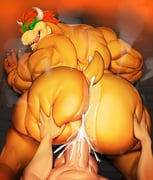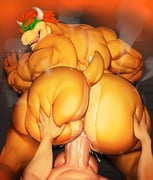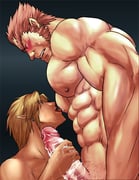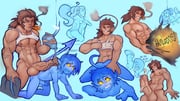Edit
Bara is a Japanese genre of manga and art (usually) by and for gay and bisexual men. With heavy focus on the masculine appeal of mature male|men.
While mostly dependent on an artist's personal tastes, the ‘bara’ archetype features 3 main body types:
- Bear-type bodies, (typically tagged as plump or fat), are generally softer and rounder looking, with varying degrees of visible musculature.
- Hunks/Jocks or muscular|Muscular-type bodies, in contrast to the chiseled triangular look of professional bodybuilders, have defined musculature that is more proportional overall, similar to that of athletic "strongman", with a wider waist, though the more chiseled appearance can be a stylistic choice.
- Twunk or otter-type bodies, tagged toned, or muscular (especially with younger or sometimes older mature males).
Musculature, when depicted, is typically more exaggerated for emphasis along with the bulge (implying an exaggerated penis size), and both are usually rather noticeable even when the subject is wearing clothes - abnormally so. When this exaggeration is paired with the points above, which assert a softer approach when drawing the male form, the 'bara' archetype becomes noticeable.
Common masculine features on subjects include: different degrees of facial hair|facial and body hair (especially the navel hair|happy trail leading to male pubic hair|pubic hair) - or a complete absence of it in the case of younger characters (depending on the artist's tastes), thick eyebrows, sideburns, scars, tattoos, bandaids, wrinkled skin|wrinkles (visible with mature male|mature and old man|old men), etc
The word "bara" literally means "rose" in Japanese. The term originally comes from the magazine "Barazoku", Japan's first gay men's magazine, with the term traditionally referring to more bishounen-esque men. The word "bara" as used here is primarily Western, stemming more from its application on art more commonly known as "gei comi", "gei manga", or "mens love" in Japan, a practice that began on Japanese imageboards, where they intentionally misappropriated the term, this interpretation later being exported abroad. Note that, like most Manga Demographics, bara is commonly defined in terms of the target audience, not the authors or the subject matter.
Bara conceptually often contrasts with yaoi, which is gay male media traditionally made by heterosexual women to appeal to other heterosexual women. Whereas bara is gay/bi male media made by gay/bi men for gay/bi men.






